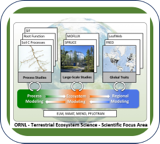Eastern US deciduous tree species respond dissimilarly to declining soil moisture but similarly to rising evaporative demand
| Author | |
|---|---|
| Keywords | |
| Abstract |
Abstract Hydraulic stress in plants occurs under conditions of low water availability (soil moisture; θ) and/or high atmospheric demand for water (vapor pressure deficit; D). Different species are adapted to respond to hydraulic stress by functioning along a continuum where, on one hand, they close stomata to maintain a constant leaf water potential (ΨL) (isohydric species), and on the other hand, they allow ΨL to decline (anisohydric species). Differences in water-use along this continuum are most notable during hydrologic stress, often characterized by low θ and high D; however, θ and D are often, but not necessarily, coupled at time scales of weeks or longer, and uncertainty remains about the sensitivity of different water-use strategies to these variables. We quantified the effects of both θ and D on canopy conductance (Gc) among widely distributed canopy-dominant species along the isohydric–anisohydric spectrum growing along a hydroclimatological gradient. Tree-level Gc was estimated using hourly sap flow observations from three sites in the eastern United States: a mesic forest in western North Carolina and two xeric forests in southern Indiana and Missouri. Each site experienced at least 1 year of substantial drought conditions. Our results suggest that sensitivity of Gc to θ varies across sites and species, with Gc sensitivity being greater in dry than in wet sites, and greater for isohydric compared with anisohydric species. However, once θ limitations are accounted for, sensitivity of Gc to D remains relatively constant across sites and species. While D limitations to Gc were similar across sites and species, ranging from 16 to 34% reductions, θ limitations to Gc ranged from 0 to 40%. The similarity in species sensitivity to D is encouraging from a modeling perspective, though it implies that substantial reduction to Gc will be experienced by all species in a future characterized by higher D. |
| Year of Publication |
2020
|
| Journal |
Tree Physiology
|
| Volume |
41
|
| Issue |
6
|
| Number of Pages |
944-959
|
| ISSN Number |
1758-4469
|
| DOI |
10.1093/treephys/tpaa153
|
| Download citation |

